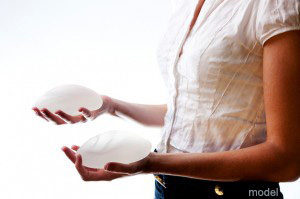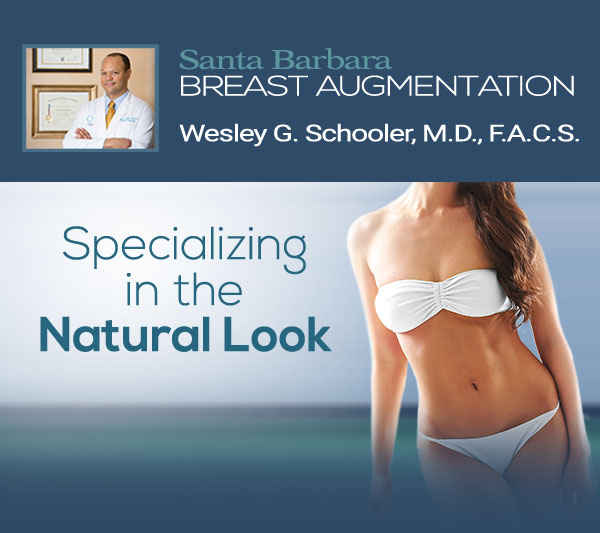Breast Implants
Women have several different breast implants to choose from for their breast augmentation procedure. Dr. Wesley Schooler, a board-certified plastic surgeon based in Santa Barbara, California, offers a wide selection of the latest breast implants at his practice, allowing patients a variety of options when selecting the best type of implant for their desired look. During a consultation, Dr. Schooler can present you with the different implant types, sizes, and shapes available at Santa Barbara Plastic Surgery Center. Based on a thorough discussion of your needs and cosmetic goals, Dr. Schooler can help you obtain a comprehensive understanding of your implant choices so you can make decisions with the utmost confidence.
- Types of Breast Implants
- Choosing an Implant Size
- Breast Implant Placement
- Breast Implant Results
- Breast Implant Complications
Implant Type
 Breast augmentation patients can choose between either saline or silicone implants. Both types of implants were developed in the 1960s, although the materials and technology used to create implants have continued to evolve and improve since that time. Saline implants were used exclusively in the United States from 1992 to 2006 while the Federal Drug Administration conducted tests on the safety of silicone-based implants. After determining that silicone breast implants pose no health risks, the FDA authorized their use once again in November of 2006.
Breast augmentation patients can choose between either saline or silicone implants. Both types of implants were developed in the 1960s, although the materials and technology used to create implants have continued to evolve and improve since that time. Saline implants were used exclusively in the United States from 1992 to 2006 while the Federal Drug Administration conducted tests on the safety of silicone-based implants. After determining that silicone breast implants pose no health risks, the FDA authorized their use once again in November of 2006.
Saline Breast Implants
Saline implants are among the most predictable and widely used augmentation devices in circulation. They consist of a silicone shell filled with saline (saltwater) solution, which is harmlessly absorbed by the body in the rare event of a tear or leak. Having been utilized to enlarge the breasts for decades, saline implants have a long record of safety and results to support their effectiveness during breast augmentation. Saline implants are usually filled after their insertion into the breast pocket, allowing a relatively shorter incision than the openings required with silicone implants. This generally translates into reduced post-surgical scarring when compared to other implant options after incisions heal.
Silicone Breast Implants
Silicone implants can be an excellent choice for augmentation, and are often preferred for breast enhancement by many patients. Made of a cohesive silicone gel inside of a silicone shell, these implants are known for looking and feeling very similarly to natural breast tissue. For this reason, many patients and plastic surgeons consider silicone-filled implants the “gold standard” for breast augmentation. Unlike saline, silicone implants keep their shape in the event of rupture and are often associated with a lower incidence of rippling. That said, in some cases, saline implants may be a better option to attain the most natural-looking outcome. Dr. Schooler will help you select the type of implant that is most appropriate for your needs.
Implant Size
For most patients, deciding upon the desired size for their new breast implants is a critical step. Several factors are considered to determine the ideal breast size, including your body type, the amount of breast tissue you have, and your cosmetic goals. To help you visualize the degree of enhancement that’s most ideal for your goals, we will show you before-and-after photos of patients who have different implant sizes. You will be able to touch and hold actual sample implants, as well as slip them inside of a light bra to get an idea of your potential contours. We will guide you through this important step to help ensure you will be fully satisfied with the surgical result.
Breast Implant Placement
Another significant decision made during the breast augmentation process involves whether your plastic surgeon should place your implants over or under the chest muscle (pectoralis). The most optimal positioning to achieve your goals depends on the unique details of your augmentation, such as the quality of your breast skin and how much natural breast tissue is available to cover your implant.
Subglandular (Over-the-Muscle) Placement
Subglandular placement is best-suited for individuals who have an adequate amount of existing breast tissue to provide proper coverage for their implants. Since this positioning is less invasive to the pectoralis when compared to an under-the-muscle approach, subglandular placement can offer the benefit of less pain and discomfort during the recovery period. However, this technique can only achieve natural-looking results for certain patients. For individuals who have naturally small breasts and/or thin breast skin, there may not be enough breast and fatty tissue to fully shield the implant, creating an increased risk of visible implant edges.
Submuscular (Under-the-Muscle) Placement
Placing breast implants under the chest muscle is typically the preferred technique for most cases of breast augmentation. Not only can submuscular placement achieve a more natural-looking aesthetic for patients with smaller breasts, but this location has also been associated with lower rates of implant rippling and capsular contracture—or scar tissue formation—when compared to the over-the-muscle approach.
How Long Do Breast Implants Last?
While breast implants are not necessarily meant to be lifetime devices, most women do not ever have the need to replace or exchange their implants. In general, a breast augmentation revision procedure is only necessary if a complication arises, or if a patient wishes to remove their implants. Alternatively, some individuals may decide to update or exchange their older devices for a different size, shape, or type of implant. In either case, we recommend remaining vigilant to potential changes in the appearance and/or feel of your breasts as you age. It’s also advised to have the state of your breast implants evaluated after 10 to 15 years to ensure they’re still in good condition.
What are the Most Common Breast Implant Complications?
Breast implants usually do not have serious side effects, but patients should still be fully educated on the potential risks and limitations of surgery before undergoing breast augmentation. In general, the most common breast implant complications include:
- Implant Rippling: A condition in which the edges of a breast implant can be seen or felt through the skin
- Capsular Contracture: The formation of scar tissue around an implant, potentially creating a feeling of tightness, hardness, or discomfort in the breasts
- Implant Rupture: A break or tear in an implant
Fortunately, these conditions can often be resolved with a breast revision procedure to correct rippling, remove hardened scar tissue, or replace damaged breast implants. The most important aspect of the entire breast augmentation process is ensuring you select a highly experienced, board-certified breast surgeon to maximize your safety during the procedure and reduce your risk of potential complications.
Today, women have many breast implant options to make their aesthetic goals a reality. A skilled and experienced plastic surgeon can provide valuable counsel in selecting the implants that are most appropriate for your needs and goals. Please contact the Santa Barbara Plastic Surgery Center to schedule a personal consultation with Dr. Schooler.

